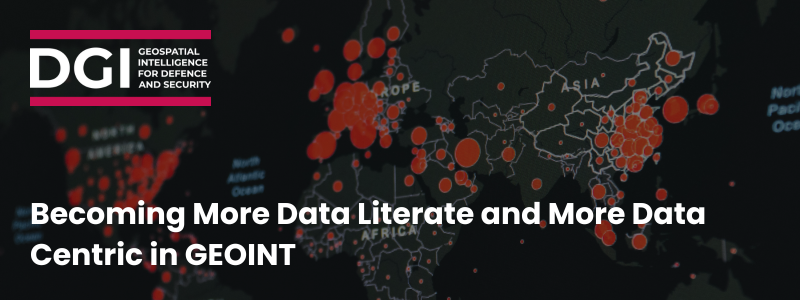Becoming More Data Literate and More Data Centric in GEOINT

Intelligence analysis, especially Geospatial Intelligence (GEOINT) analysis, has undergone a variety of transformations over the years. These transformations center not just around the use and availability of that data, but also the nature of the analysis environment with which it is conducted.
Outlining the Challenges
Historically, GEOINT analysis has largely been driven by ambiguity, data scarcity, biases, and assumptions, with analysts relying heavily on intuition to fill data gaps (Johnson & Wirtz, 2004). Structured Analytic Techniques were introduced to help identify and mitigate these data gaps and human-centric challenges in a systematic, collaborative way (Pherson & Heuer Jr., 2021). But the GEOINT community has been rapidly shedding the data scarcity skin. Imagery sensors are continuously being launched and adding to the volume and variety of data that GEOINT analysts can work with, to the point that there aren’t enough skilled analysts to analyze and interpret the data. In addition to imagery sources, other sources of geospatial data further add to the information that analysts need to consider. The challenge has now changed from data scarcity to data surplus: how to analyze the volume and variety of information in a timely manner to provide intelligence to those who need it when they need it and know that you have the data you need to do so in that wealth of data. Couple these data changes with everchanging and complex intelligence questions (which require complex methodologies, like Activity Based Intelligence, to answer (Atwood, 2015; Biltgen & Ryan, 2015)) and a broadening of GEOINT partnerships across the globe (Ballast, 2017), and we see a great need for data literacy and to become the standard in GEOINT.

Ways Ahead
To incorporate the volume and variety of data to answer complex questions quickly, efficiently, and repeatably across the global GEOINT community, leaders in the GEOINT discipline must continue to prioritize data literacy and centricity (where data becomes the core of GEOINT analysis), making it the standard for conducting GEOINT analysis. To achieve those goals, we can start with a few steps towards data understanding:
- Set global data interoperability and metadata standards. Developing, adhering to, and enforcing global interoperability and metadata standards for GEOINT data will allow the community to meet the challenges of our discipline in a common way (Sun et al., 2019; Kemp et al., 2007). This applies not just to common geospatial data formats, but to emerging formats like knowledge graphs and three-dimensional data (Guyo et al., 2021). Common interoperability and metadata standards will allow for the rapid employment of common methodologies from across the global community leading to more timely results at all operational levels, from strategic to tactical. It will also give educators a common framework to prepare students for.
- Training analysts on how to evaluate and triage data. The increasing volume and variety of data can be overwhelming and exciting. Analysts might think that all data are created equally, but they are not. Some data may have location inaccuracies. Some data may contain inconsistent or incorrect attribute values. Some data may not contain metadata detailing the methods for collection to ensure validity. All of this may impact an analyst’s ability to use the data. Educating analysts in how to evaluate geospatial data they are receiving, including quantitative and qualitative metrics, will serve to increase the accuracy and effectiveness of analysis across the community.
- Set goals for recording and using data for GEOINT analysis. Training in data evaluation is helpful when receiving data, but many times, analysts are recording their own data (or collecting) for use in analysis (O’Connor, 2023). Knowing how to evaluate data may help analysts be better data users, but it may not necessarily illustrate the best ways of recording their information in a useful way. Illustrating how data might be used in analysis and reverse engineering how to structure data in a meaningful way to assist those analyses could be very informative.
First Steps
While not the totality of goals that need to be set to generate data literacy and centrality within GEOINT, these three goals are steppingstones on the path and will level set, creating a better understanding of data overall. Encouraging analysts to apply their critical thinking not just to the analyses they’re conducting, but also the data that they’re using, will be the basis of becoming more data literate and data centric within our discipline. Once achieved, more complex data literacy and centrality goals can be set.
References:
Atwood, C. P. (2015). Activity-based intelligence: Revolutionizing military intelligence analysis. Joint Force Quarterly, 77(2nd Quarter).
Ballast, J. (2017). Trust (in) NATO: The future of intelligence sharing within the Alliance (pp. 1-16). NATO Defense College.
Biltgen, P. & Ryan, S. (2015). Activity-Based Intelligence: Principles and Applications. Artech House Publishers.
Guyo, E., Hartmann, T., & Ungureanu, L. (2021). Interoperability between BIM and GIS through open data standards: An overview of current literature. Proceedings of the 9th Linked Data in Architecture and Construction Workshop.
Johnson, L. K. & Wirtz, J. J. (2004). Strategic Intelligence: Windows into a Secret World. Roxbury Publishing Company.
Kemp, Z., Tan, L., & Whalley, J. (2007, March). Interoperability for geospatial analysis: a semantics and ontology-based approach. In Proceedings of the eighteenth conference on Australasian database-Volume 63 (pp. 83-92).
O'Connor, J. (2023). A Short Introduction to Geospatial Intelligence (1st ed.). CRC Press.
Pherson, R.H. & Heuer Jr., R. J. (2021). Structured Analytic Techniques For Intelligence Analysis (3rd ed.). Sage.
Sun, K., Zhu, Y., Pan, P., Hou, Z., Wang, D., Li, W., & Song, J. (2019). Geospatial data ontology: the semantic foundation of geospatial data integration and sharing. Big Earth Data, 3(3), 269-296.
About the Author:
Leanne Sulewski is currently an Adjunct Instructor at Penn State University, where she has taught GEOINT-related courses since 2021. She is also an Analytic Methodologist for the US Department of Defense and an adjunct instructor at the National Intelligence University. She received her PhD in Geography from the University of South Carolina in 2013. Her current research interests include migration, spatial visualizations, and GIScience.